Allweil: Independence Haggadah
INTRODUCTION
When I began working with the daughters of artist Arieh Allweil (1901-1967), I though my Allweil blog posts would end with his Scroll of Lamentations (1943,) the last of his Bible-related books that he illustrated with vibrant, original linocuts. Then I purchased on eBay his first Haggadah (c.1941) that his daughters had overlooked. So I blogged on that because it too had his linocuts.
That left three more Allweil Haggadot than I did knew about but didn’t intend to write about because they were not illustrated with new relief prints. And as a collector focused on original relief prints, neither his Chapters for Passover Celebration (1948) with lithographs, nor his IDF Passover Haggadah (1949) with linocut reproductions, nor his Haggadah of 1950s with reproductions of his oil paintings ever really excited me.
That is until further emails exchanged with daughters Ruth Sperling and Nava Rosenfeld made me realize how those three were so intertwined with the independence of Israel in 1948. And that’s the story I now want to tell, beginning with Chapters for Passover Celebration.
Links to the ten previous ART I SEE posts on the oeuvre of Arieh Allweil can be found HERE.
The contents Allweil’s Haggadot, preliminary drawings and related photos
are presented courtesy of the Estate of Arieh Allweil.
The Chapters for Passover Celebrations
The independence movement, Ruth Sperling wrote, was “his dream. As he was 47 years old in 1948, he was too old to register.” The Chapters for Passover Celebration became part his independence effort.
As the name implies, this is not a Haggadah. It was rushed to publication in the days leading up to 14 May 1948, the day Israel became an independent state. As Sperling wrote in an email: “Our father’s Chapters for Passover included only small parts of the Haggadah with the emphasis on freedom and the independence war that was going on.”
This urgency perhaps is why Allweil used the more expedient medium of lithography to illustrate the text. By choosing lithography, his drawings did not first have to be recreated on linoleum blocks, a process he had used for all of his books from 1939-1943. With lithography, the drawings and the text (Allweil penned all of the calligraphy except for the songs on the back cover) could be photographed at the same time, and those photos could be used to make plates that could be printed via offset lithography.
When asked how Chapters came about, Sperling wrote: “It is important to note that this is not a traditional Haggadah, but historically, I think, it is very important. In the Jewish calendar, Passover is celebrated three weeks before the 5th of the month of Iyar, Israel’s Independence day. So in 1948, when this Haggadah was created, Pesach [Passover] was celebrated three weeks before the declaration of the State of Israel, while the Independence war was going on. The IDF [Israel Defence Forces] did not exist yet, and these Chapters for Passover were issued by the Haganah*, and one can sense the excitement of the new state in-the-making (change from the British Mandate period, with block of immigration of Holocaust survivors, to the declaration of statehood).”
* Haganah was the primary Zionist paramilitary organization in operation from 1920 to independence.
She added: “In Israel, Passover is celebrated not only as a religious or traditional holiday, but as a holiday celebrating freedom, and in 1948 this was the birth of the State of Israel.
“These Chapters of Passover might have [reflected] some influence from the Haggadot of kibbutzim. Passover was celebrated in the Kibbutzim in a non-religious traditional manner with emphasise on freedom and on agricultural events, in Passover celebrating harvest. Each Kibbutz used to issue a non-orthodox Haggadah, including only small parts of the traditional Haggadah, with additional literary texts and songs of harvest and freedom.”
And when asked about the publisher, edition size and distribution, Sperling stated: “On the printed back cover it is written: Illustrated by Arieh Allweil. Printing house Y. Shlomi, Tel Aviv, Zvulun 29th St. We don’t know the edition size. It was issued by the Haganah for the soldiers of the Haganah. Although we don’t know how it was distributed. We assume it was distributed by the Haganah to all soldiers of the Haganah wherever they were stationed to celebrate the Seder.
“Few years ago, Nava and her late husband Ami visited the Yad Mordechai Museum: From Holocaust to Revival. (Yad Mordechai is a Kibbutz named after Mordechai Anilevitch.) They saw at the entrance to the museum a poster of the cover of Allweil’s Chapters for Passover 1948, with signatures of the soldiers who celebrated the Seder there in 1984, before they went to the battle. Not all came back.”
The following are all of the pages of Chapters with translations from the Hebrew (by Rosenfeld) and added commentary (by Sperling) in places:
To the Holiday of Freedom לחג החרות
1948 תש”ח
Allweil אלואיל
Chapters for Passover Celebration פרקים למסיבות פסח
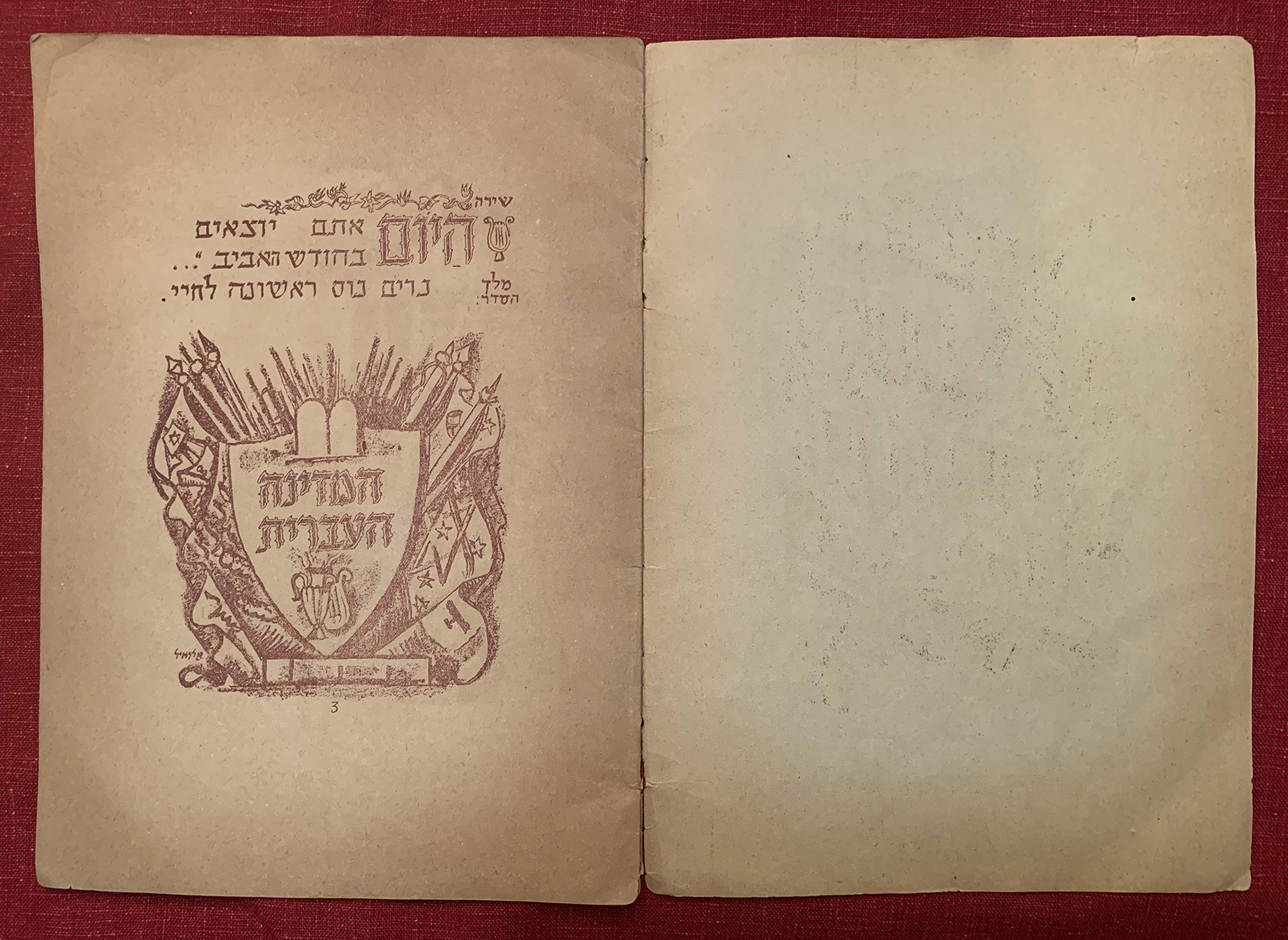
(Text above) Singing, this day came thee out “in the month of Aviv.”
Note: Allweil drew a tiny image of a harp to indicate notification of a song on this and other pages.
Exodus, Chapter 13/4. The King of the Seder. We lift (fill) the first cup (of wine) to
(Text in the cartouche) The Hebrew State המדינה העברית
Commentary from Ruth Sperling
In the traditional Haggadah we drink four cups of Wine. In Allweil’s Chapters for Passover each wine cup is dedicated:
1st cup: To the life of the Hebrew State (the name “State of Israel” apparently was not decided yet when these chapters were prepared).
2nd cup: To the life of The Haganah.
3rd cup: To the Immigrations (העליה).
4th cup: To the life of each military unit (who celebrated the Seder before going on to battle)
Page 4: (From the Haggadah) The king of the Seder lift up the matsos and read aloud: This is the bread of affliction which our ancestors ate in the land of Egypt. Let all that are hungry enter and eat; and all who are in want come and celebrate the Passover. This year we are bondsmen here, but next year we hope to be free men.
Page 5: (tiny letters upper right) The youngest of the unit הצעיר שביחידה
(From the Haggadah) ….. Wherefore is this night distinguished from all other nights
Page 6: (From the Haggadah) Because we were slaves unto pharaoh, and the Eternal, our God brought us forth.
(Bottom line of text) Song שירה
I am ready and willing הנני מוכן ומזומן
Page 7: Exodus A 8-11, 13-14
(tiny letters at the bottom) Song שירה, Exodus A/12 שמות א י”ב
Page 9: (lettering around the image of the bowl filled with produce) Exodus 5 1-5, 7, 9-10 שמות ג א-ה
Song שירה, (from the Haggadah)When Israel went forth from Egypt בצאת ישראל
Page 10: Go לך, (text by D. Frishman)
Page 11: (right of the image) The king of the Seder says מלך הסדר
Let lift the second cup to the Haganah נרים כוס שנייה לחיי ההגנה
NOTE: Allweil drew a tiny glass to indicate where to drink wine
(tiny letters) Song שירה
(from the Haggadah) והיא שעמדה
And it is this promise which has been the support of our ancestors and of ourselves, for not one only has risen up against us, but in every generation some have risen against us to annihilate us, but the most Holy, blessed be he, has delivered us out of their hands.
Page 12: (from the Haggadah) פסח The Pesach lamb which our ancestors ate during the existence of the holy temple
מצה This matso, which we now eat, what doest it signify?
Page 13: (from the Haggadah) מרור This bitter herb, why go we eat it?
בכל דור ודור In every generation each individual is bound to regard himself as if he personally has gone forth from Egypt.
Page 14: To give us this land לתת לנו את הארץ
He swears unto our fathers אשר נשבע לאבותינו
(tiny letters) King of the Seder מלך הסדר
We lift the third cup to the ascent (immigration to Israel) העליה
Page 15: The Heroes (top image, left to right) Mordechai, Yehuda, David, Devorah, Shimshon, Yehoshua
(bottom images) Fighter for Revival (left) Hero of the Ghetto (right)
(text) (From the Haggadah and Psalms 79) שפוך חמתך על הגויי
Pour out thy wrath upon the heathen who knew thee not, and upon the kingdoms who invoke not thy name, for they have devoured Jacob and laid waste his beautiful dwelling. Pour out thy indignation upon them, and let thy fierce anger overtake them. Pursue them in wrath and destroy them under the heavens of the Lord.
Commentary from Sperling
An additional unique element of these Chapters for Passover is the Heroes of the Haggadah. In Page 15 you can see six Biblical heroes: Mordechai, Yehuda, David, Devorah, Shimshon and Yehoshua. Allweil added two modern heroes: the Hero of the Ghetto, and Fighter of Revival (for the State of Israel).
Page 16: Arise קומו
(Lyrics by H. N. Bialic, beginning with) Arise, wander in the desert, and come out of the wilderness. There is still a long way to go; there is still a lot of war.
Page 17: Another house will be built בית אחר ייבנה
Another tent will be erected אהל אחר תקים
Page 18: King of the Seder מלך הסדר
We lift נרים
The fourth cup כוס רביעית
to the life of the unit לחיי היחידה
the name of the unit שם היחידה
(in the drawing) to Freedom לחרות
Feast סעודה
Back Cover: List of Passover songs רשימת שירי פסח
15 songs (6 from the Haggadah)
Israeli Post Office honors Allweil
In 2017 the Israeli Post Office issued three stamps for Passover, one of which is taken from Page 11 of Allweil’s Chapters for Passover Celebration. Above the eight stamps on the sheet (see above) were images of the Heroes from Page 15.
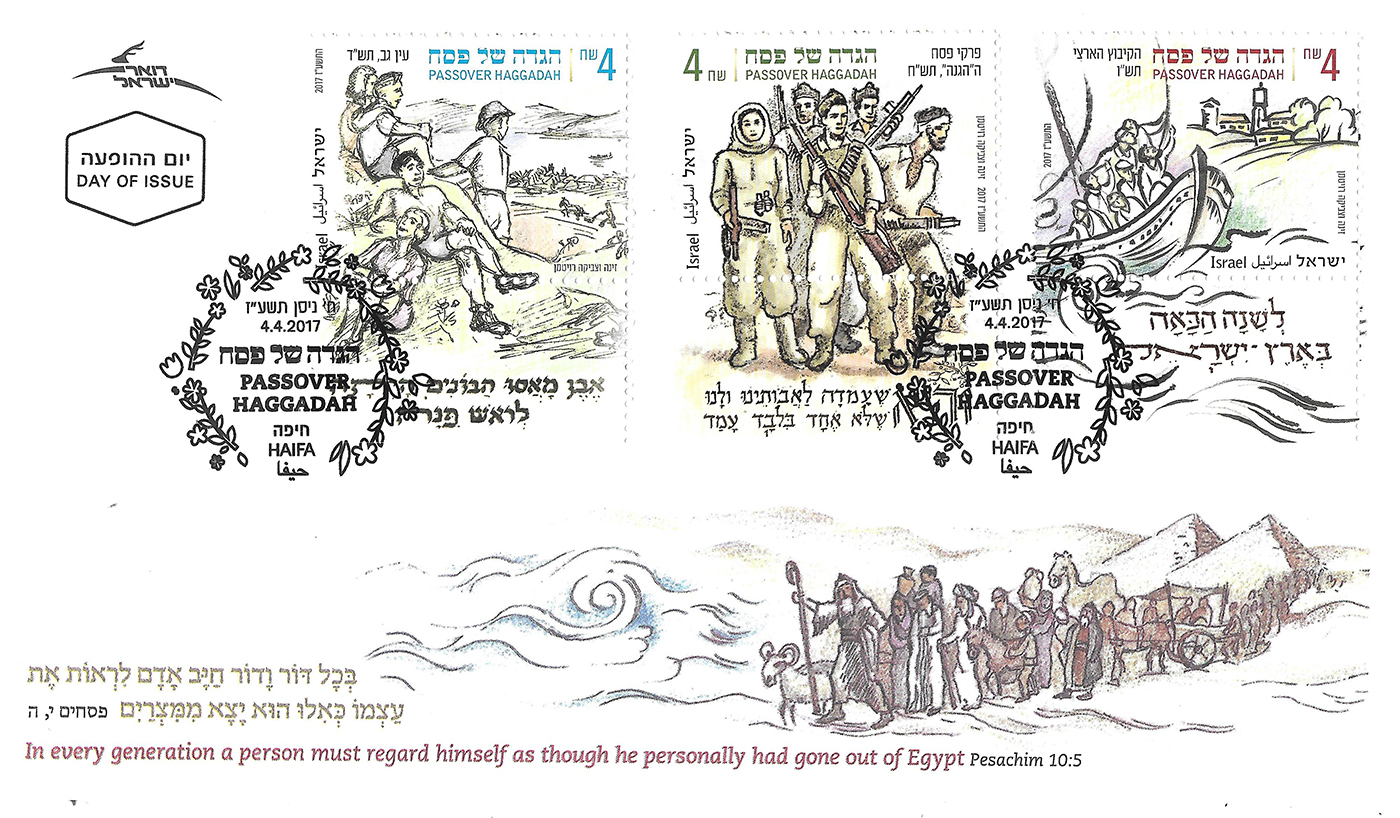
This is the envelop from the Day of Issue, showing all three Passover stamps for 2017.
This page describes all three stamps. Allweil’s image is referred to in the Pirkei Pesach paragraph.
Up Next: Arieh Allweil’s IDF Haggadah
His daughters have provided paste-ups for all of the pages. These were then photographed to make plates for this Haggadah, the artist’s first for the new State of Israel.
Comments Welcome
Trackback URL: https://www.scottponemone.com/allweil-independence-haggadah/trackback/


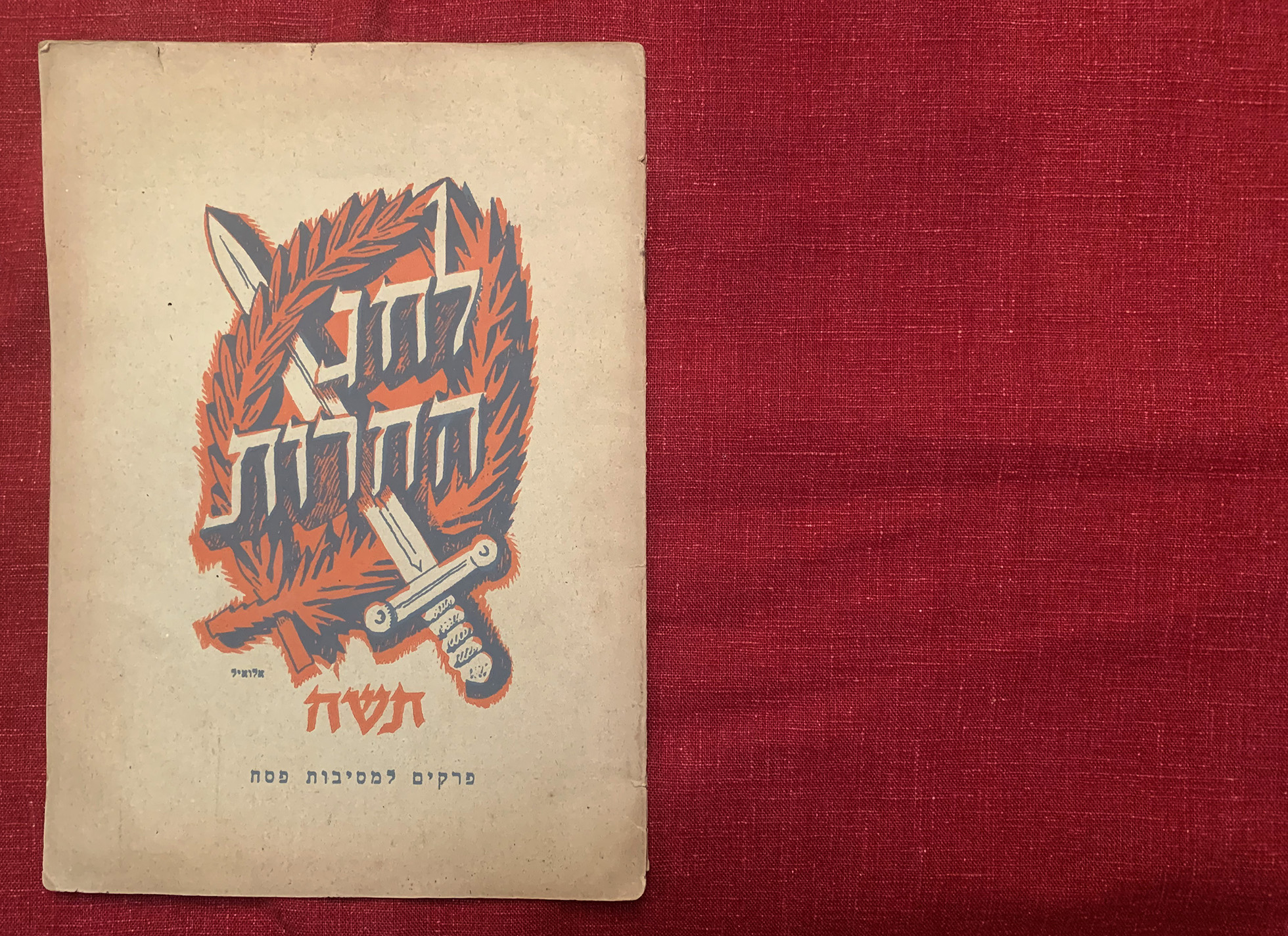
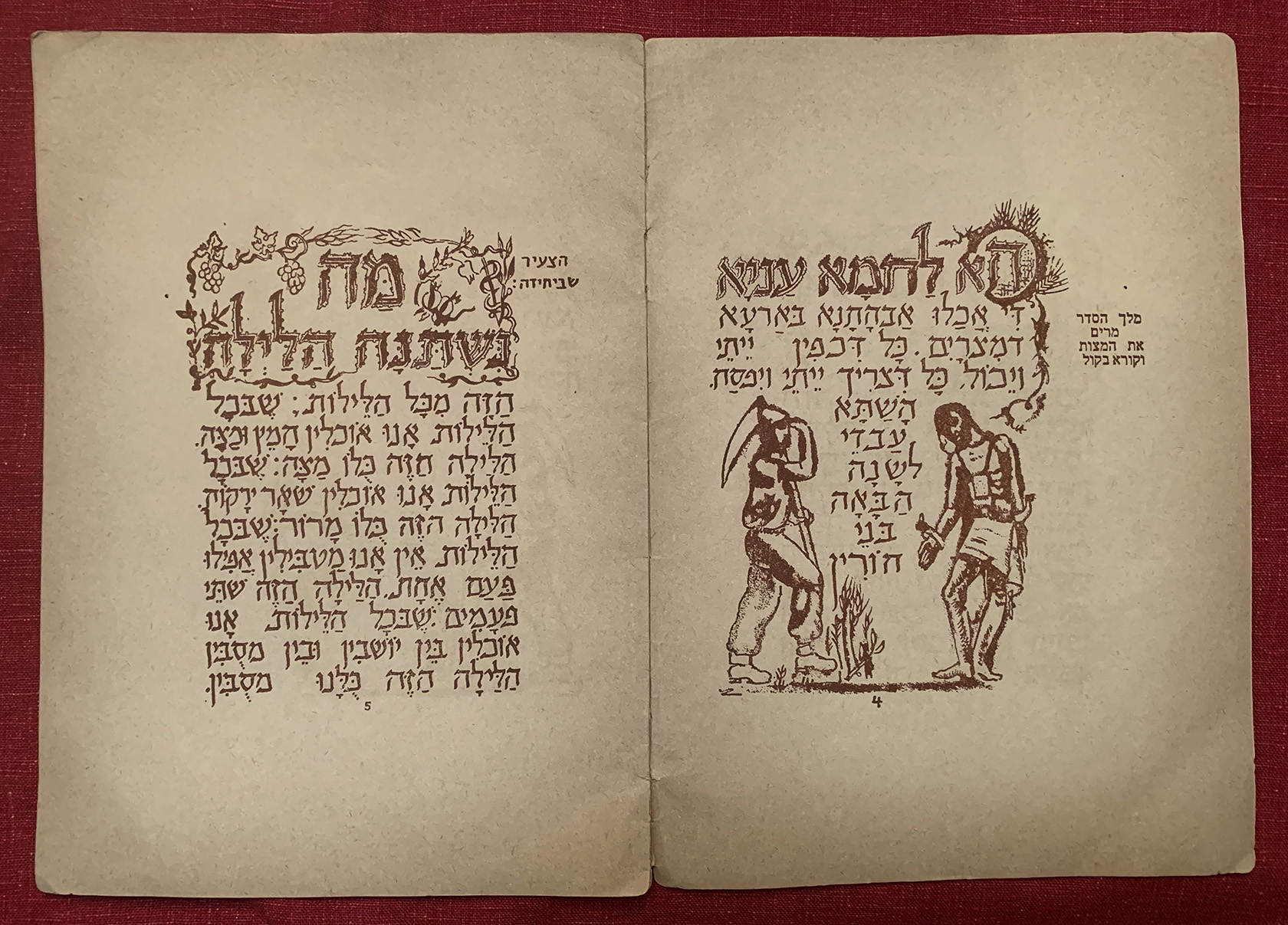
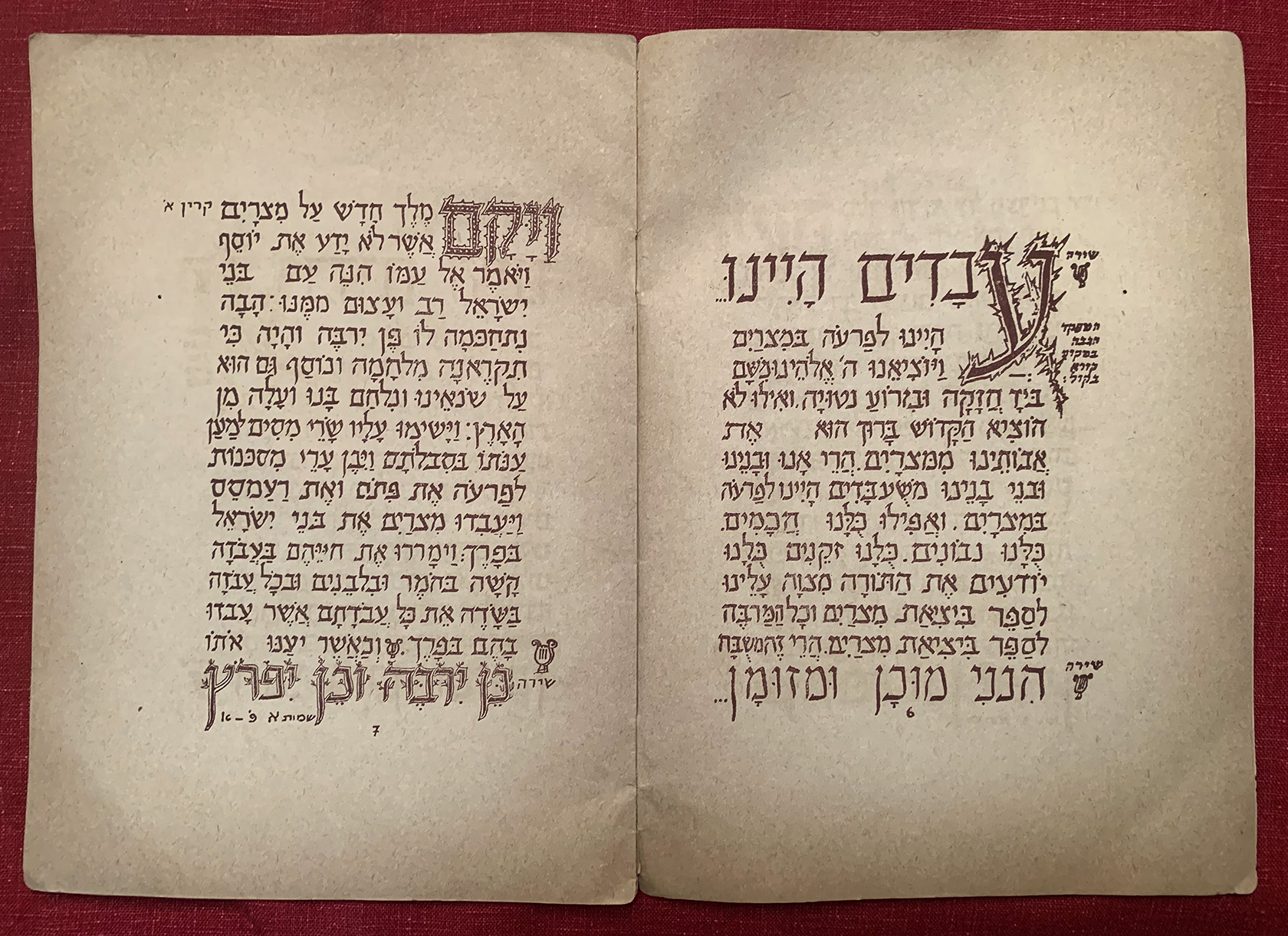
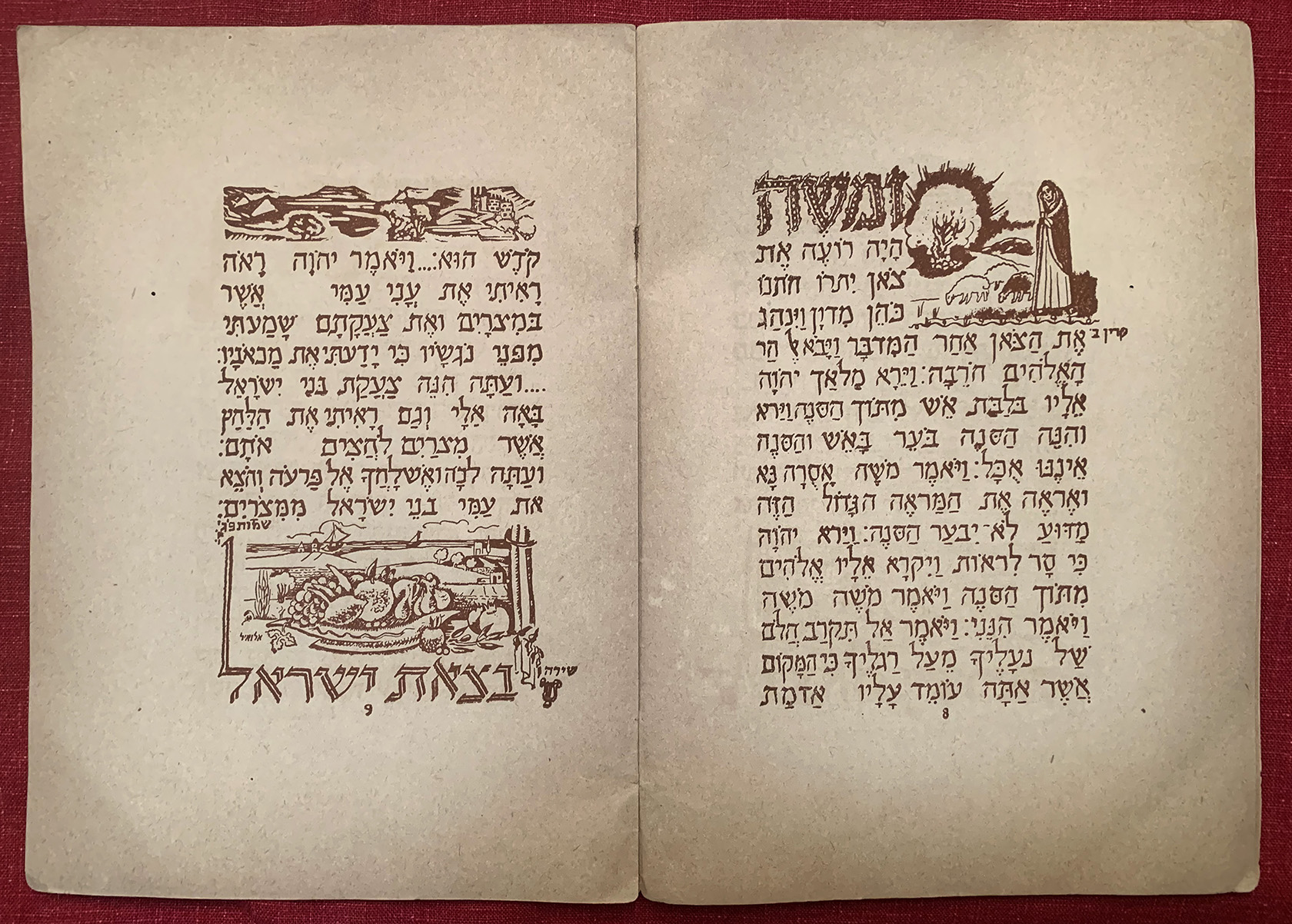
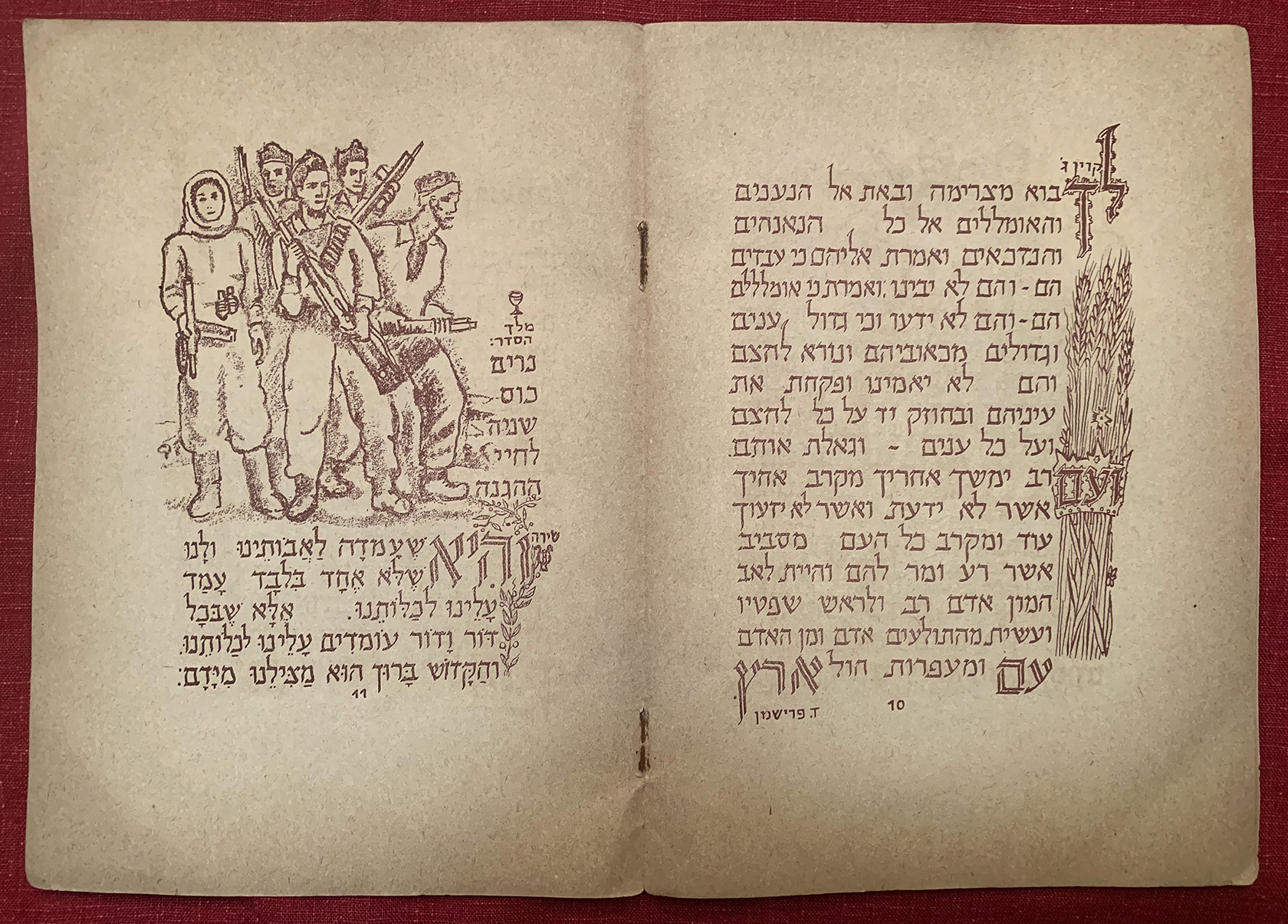
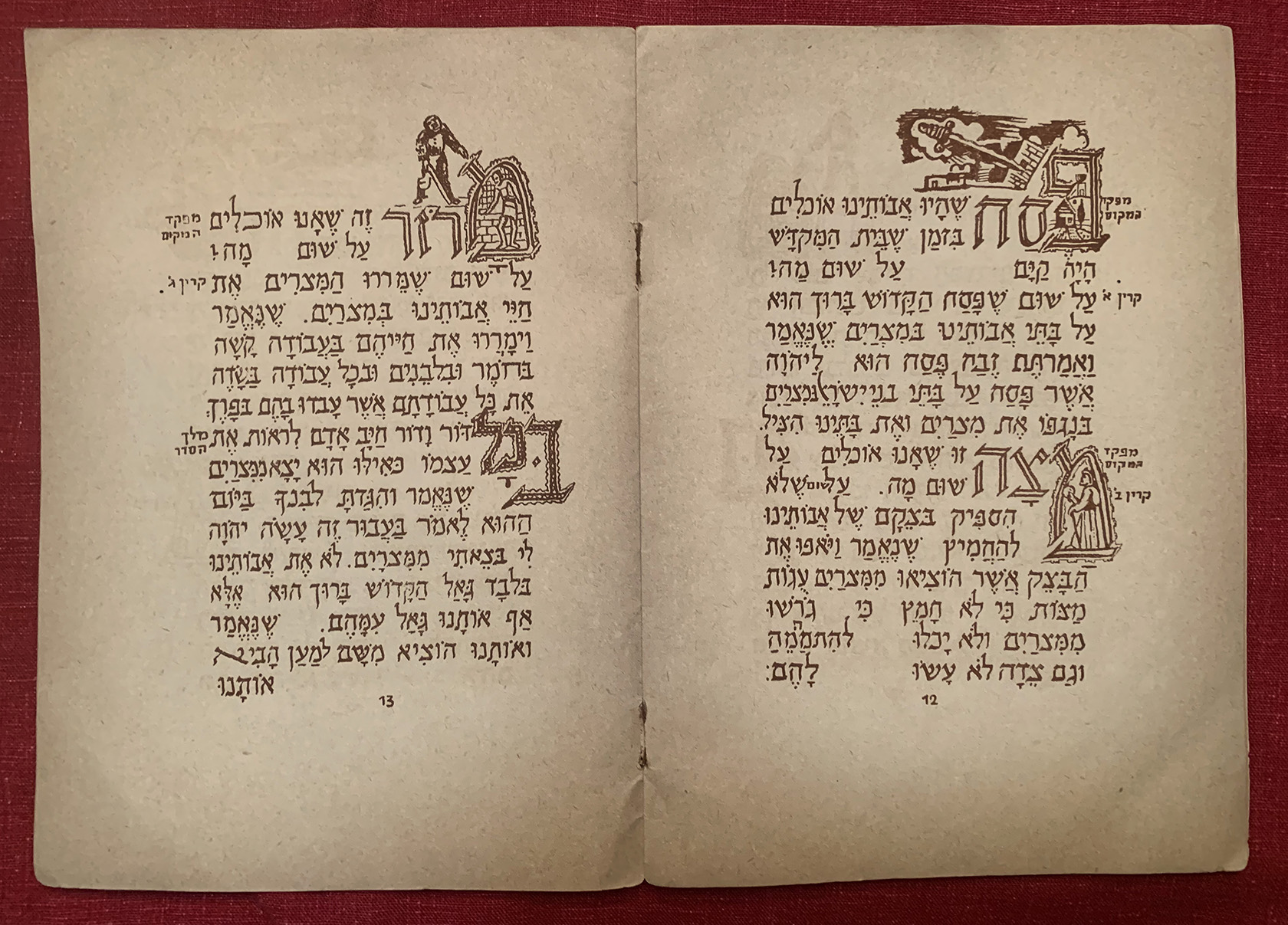
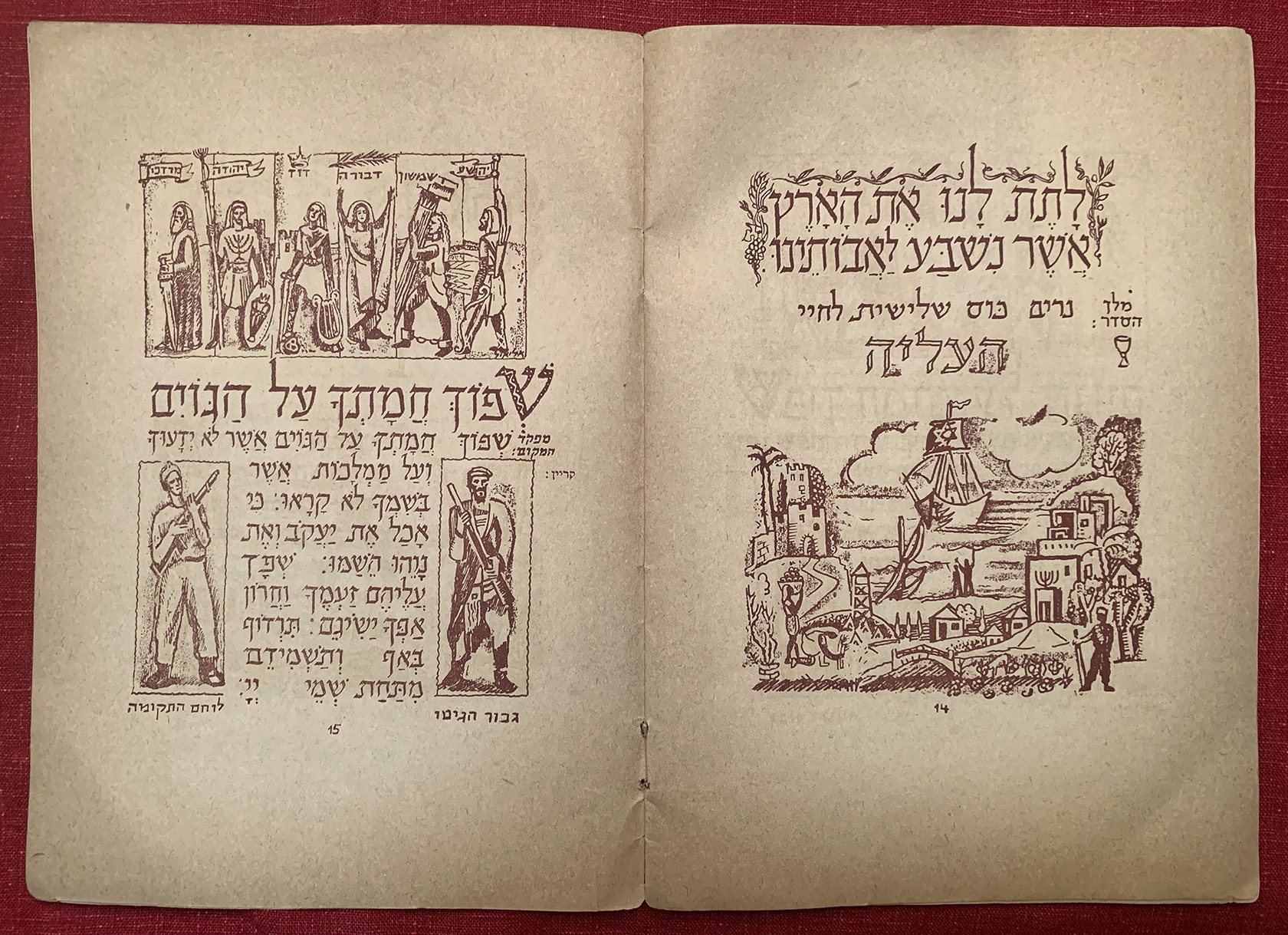

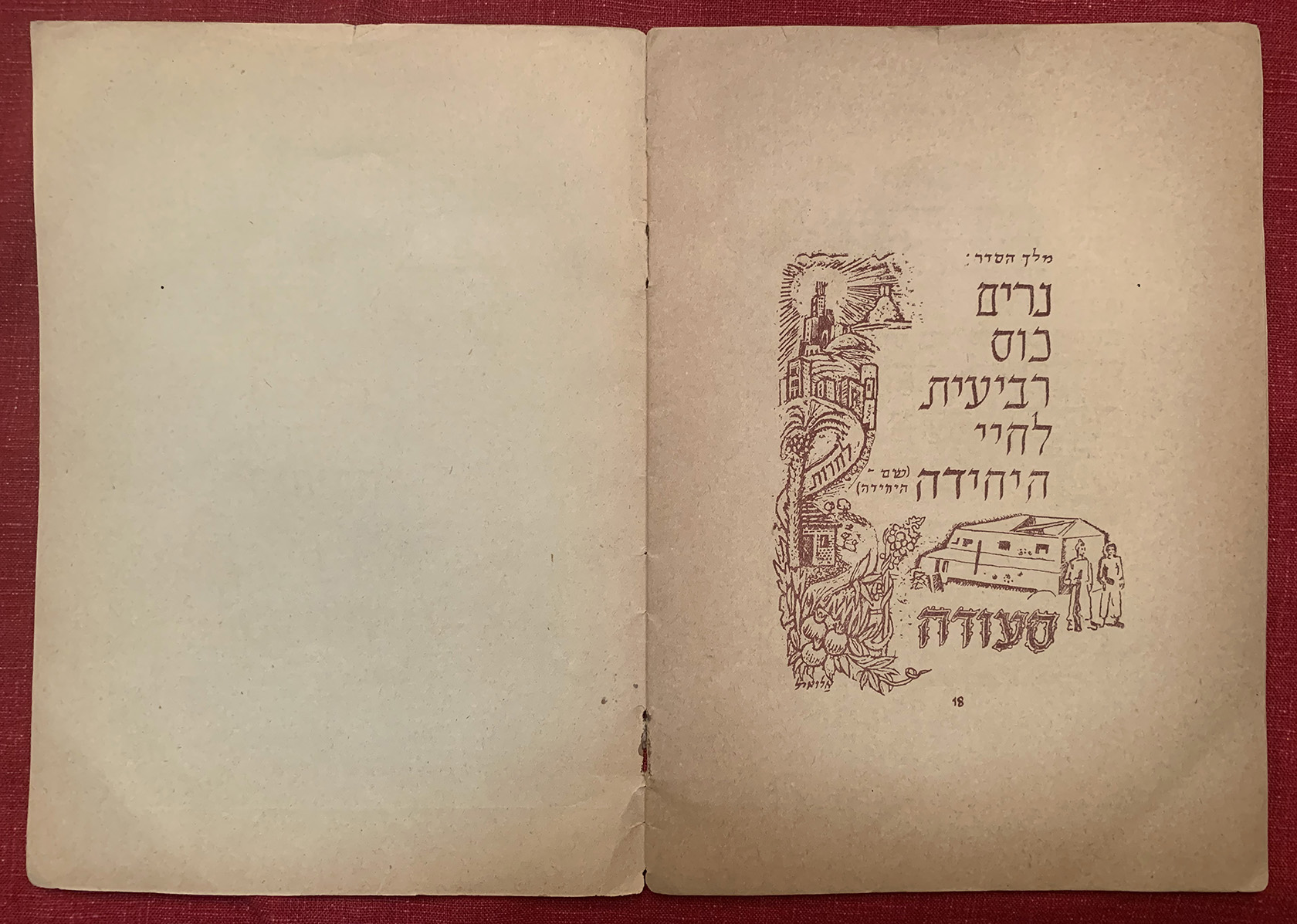
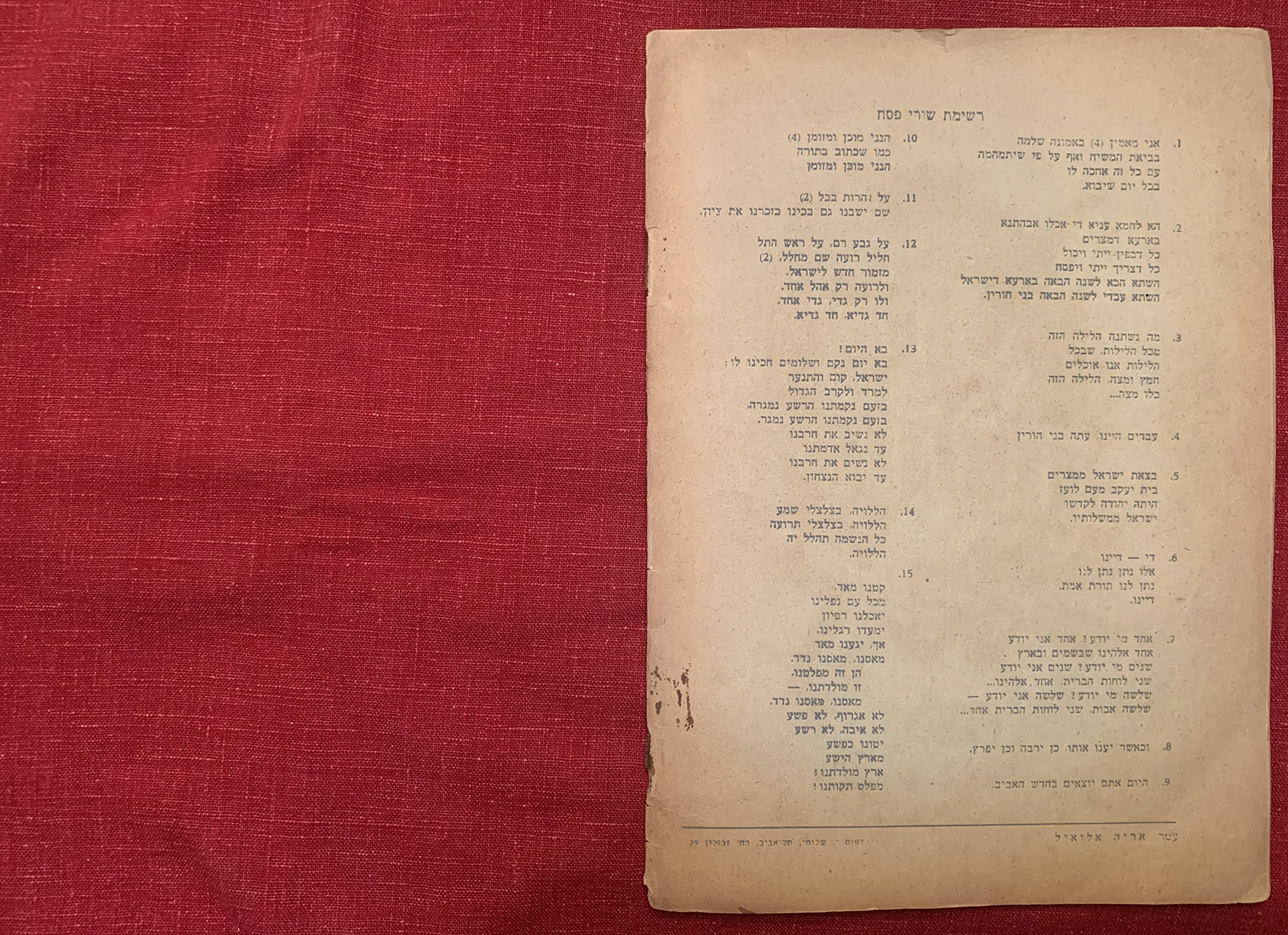
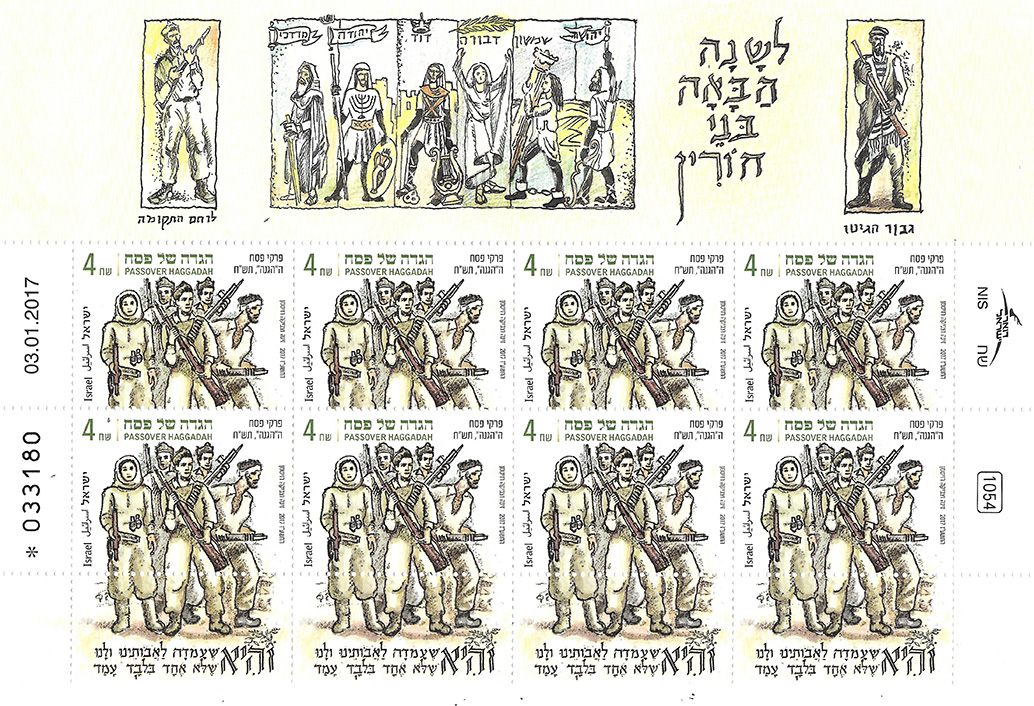
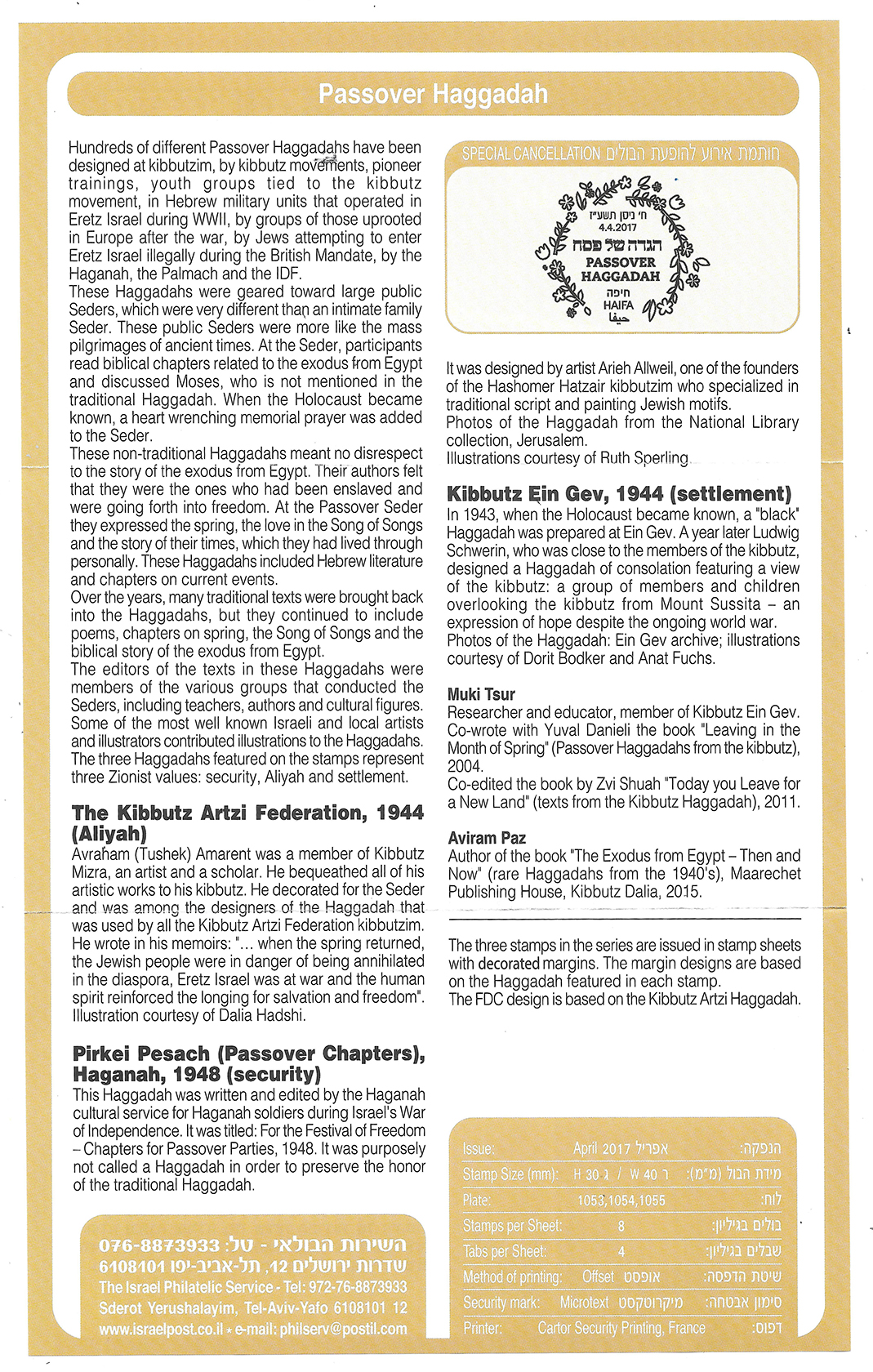
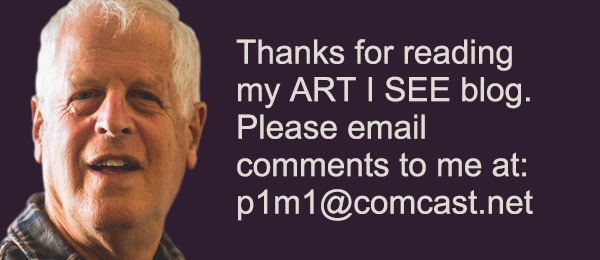










Pingback: Arieh Allweil’s IDF Haggadah